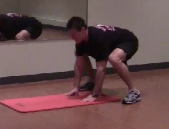The workout consists of three, 10 minute intervals each with a different focus. The first 10 minutes focuses on anaerobic recovery, the second ten minutes on full body strength and the last ten minutes on fire ground related movements.
The only equipment needed for the intervals are a 50 feet bundle of fire hose (2 1/2 inch works best), some stairs if you got them (or a jump rope), a place to do body rows (pull up bar) and an interval timer (there are android phone apps for this).
Interval 1. Sprints. This interval requires a little space, you can use the garage bay or parking lot. Set your interval timer to 30 seconds of work and 30 seconds of rest for 10 rounds (10 minutes total). Start the timer and walk around the bay or parking lot for the first 30 seconds. The second 30 seconds you should sprint at 50% pace. Continue to walk during the first 30 seconds (recovery or rest) of each minute and running (sprints) the second 30 seconds for 10 rounds total. As each minute progresses your speed and effort level should follow suit. For example the first sprint should be at 50%, the second 60%, the third 70%, the fourth 80% and so on. As soon as you finish your last interval immediately reset the timer and proceed to interval #2.
Interval 2. Full body strength. This interval consists of 3 exercise performed with either 30 or 40 seconds of work (40 for intermediates and 30 seconds for beginners) and 20 or 30 seconds of rest. You should do each exercise 3 times for a total of 9 minutes, the last minute you should hold a plank.
Here are the exercises:
- body row
- Squat to press (use the 50 ft. hose bundle for your resistance)
- push-ups
**Repeat this circuit 3 times then hold the plank for the final minute. After you complete the plank rest the times and progress to interval 3.
Interval 3. Fire ground Movements. This interval should be performed with the same time parameters as interval 2. This interval will require you to perform exercises (or movements) that are synonymous with the fire ground. Here are the exercises"
- Climbing stairs
- Floor crawl
- Hose Drag (grab both couplings of the 50 ft of hose pull, for more of a challenge pull the LDH hose)
**Repeat this circuit 3 times then hold the plank for the final minute. After the last interval, grab some water and foam roll.








